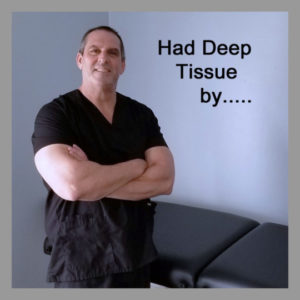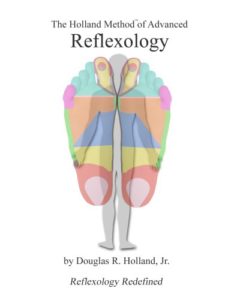Our office in Cortland is located at:
480 South Mecca St., Cortland, Ohio 44410
Phone 330-637-3056
Doug Holland is a Licensed Massage Therapist who specializes in:
- Deep Tissue
- Sports Massage
- Reflexology
What are some conditions that Doug treats regularly with high success of outcome?
- Plantar Fasciitis and Thoracic Outlet Syndrome
- Sciatica and Diabetic Neuropathy
- Hyperlordosis and low back pain
Want to get to know Doug’s work in action?
Watch his YouTube channel on giving massage tips to massage professionals.
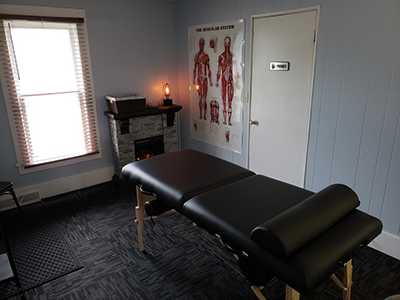
Our treatment room
Forms of payment: We accept check, credit or debit.
Fee: For massage (which includes reflexology) $140.00 (includes tax). Approximately 80 minutes.
Fee: For neck/shoulders only $70.00 (includes tax). Approximately 30 minutes.
Fee: For reflexology $70.00 (includes tax). Approximately 30 minutes.
Our schedule is as follows:
Tuesday 8am-9pm
Wednesday 8am-9pm
Friday 8am-9pm
Saturday 1pm-6pm
Emergency issues on Saturday or Sunday for current clients- please call and we may be able to get you in.
Who could benefit from deep tissue massage?
Muscular imbalances in the body are responsible for many of our serious aches and pains or poor performance in sports.
Leg cramps are one example.
Deep tissue massage as well as purposeful stretching by the therapist can bring relief from those medical conditions.
Doug specializes in separating muscle bodies (muscle stripping) to separate fascia adhesions that either develop from injury, poor sports performance or the ergonomics of the workplace.
Have you had true Deep Tissue Therapy in the Youngstown area?
People from Howland, Poland, Canfield, Austintown, and surrounding areas have been pleasantly surprised by the difference in the “Deep Tissue Massage Technique” used at Holland Massage and Reflexology.
What is the surprise?
Not just Deep Tissue in name, but action. Doug believes that the massage therapist’s motivation is to sacrifice their energy on behalf of their patients.
This means using the thumb and fingers to dig deep into the muscular tissue to relieve sore and tight muscles, as well as contortion stretching.
Sports Massage certainly demands it! And this requires strength and endurance.
(Doug Holland, LMT explains the difference between deep tissue and DEEP TISSUE massage.)
Why Deep Tissue For Painful Muscles?
Let’s give you an example: Say a patient comes in with a kyphotic posture (rounding of the upper back) which gives them pain in the upper shoulders and neck (forward head posture).
They constantly say, “I wish someone would rub my shoulders and neck to relieve some of the tension.”
So someone does and they feel brief relaxation. Why is it so brief?
Because the deep muscles of the neck and shoulders were not addressed. Lets explain:
Most massages that are given only tease the most superficial muscles (close to the skin) and neglect the deeper, more critical, tissue.
Now if you hate reading anatomy and physiology you might want to skip down past this medical explanation.
We are going to start with:
- Why the neck muscles are tight in the first place
- What are their names (anatomy)?
- How we work them
- What happens to the muscles and tissue (physiology)
- Why Deep Tissue is therapy and not “FooFoo” feel-good massage
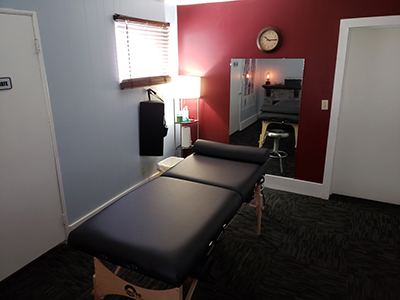
Also our treatment room
Why are the neck and shoulder muscles so tight?
Our deepest muscles are postural muscles, meaning they help keep our body erect. Good posture is almost lost on today’s society due to the type of work we do, the use of cell phones, computers and lounge chairs that lie in front of the TV.
This forward posture causes the upper back to round, and the head to sit forward like a turtle head. Thus the medical term for the rounded upper back is called “Kyphotic Posture”, and the neck “Antro-Torticollis.”
These muscles took a long time to become distended and dysfunctional. The longer the incorrect position, the tighter and harder the muscles became to keep your head from falling off.
So in order to reverse this process we need to go deep and strip fascia adhesions from the endomysium, perimysium, epimysium, from those postural muscles.
We also need to stretch / cross-fiber friction trigger points and scar tissue, so that muscle spindles can function efficiently again.
Put this way – To be performed properly, it’s a workout for the Deep Tissue therapist and it ain’t easy.
The patient also suffers from the discomfort required to find those trigger points and shortened overworked muscles.
That is why we believe that there is a difference between deep tissue and DEEP TISSUE.
When Doug practices Sports Massage he is sweating along with the patient. Both are getting a workout.
What are the muscles names that effect the neck and shoulders due to a kyphotic posture?
When doing a Deep Tissue massage we work from superficial (close to skin) to deep (spine).
The closest to the skin is the trapezius muscle, followed by splenius capitis, sternocleidomastoid, longissimus capitis, rectus capitis posterior major and minor, obliquus capitis inferior and superior, spinalis capitis, intertransverse, rotaries, multifidus, ect.
We also have to dig through fascia and subcutaneous layers.
Example: Reach back and touch the back of your neck in the center. Do you feel that rope like substance? That’s called the “ligamentum nuchae.”
It’s a tough fibrous / fascia type connective tissue we must work to get through in order to work the deeper muscles.
That takes a lot of strength and skill on the therapist part as well as pain tolerance on the part of the patient.
However, if neither the massage therapist or the patient are willing to do what ever it takes to reach those dysfunctional muscles, the massage might as well be called “FooFoo Lite”.
Nothing wrong with that on a cruise ship, but certainly should not be called “Deep Tissue Therapy.”
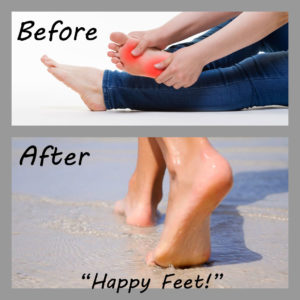
Now lets talk about Reflexology.
While reflexology targets the nervous system, it can also help with conditions like Plantar Fasciitis and Diabetic Neuropathy.
(Doug’s article on how reflexology can help plantar fasciitis is found here.)
Reflexology helps by removing the toxins and congestion in your feet such as calcium and uric acid that block nerve impulses that affect your health. In other words, to have good health you need to have good circulation in your feet.
Reflexology can also be performed on just the hands or on the hands and feet together. Hands are more for circulation and the breaking up of arthritic crystals for greater articulation.
Who could benefit from hand reflexology?
- Elderly experiencing difficulty in hand tasks (opening a jar of pickles!)
- Professionals who type (word processor)
- Gardeners, Landscapers, Quilting & Sewing
- Those with arthritis and other abnormalities of the hands that cause loss of strength in the hands.
Doug’s book on reflexology is now for sale online and is in full color.
We are thankful for the wonderful feedback we received for our massage therapy practice. Here are a few of our reviews from Google.
Cora Harshman,
“I highly recommend this therapy. I started going to Doug three years for reflexology.
I couldn’t walk without pain. Last year, I ran my first 5K at age 50. I have suffered with discomfort from past injuries for a long time. After message and reflexology, I am able to step out of bed with no pain.
After suffering with hip, feet, shoulder, and neck pain for a long time, I feel great.
Doug, thank you for all of your hard work. Your skill is so valuable. My life is better thanks to you.”
Todd Fabian,
“I started seeing Doug a few months back for reflexology. Almost an instant relief from some lingering effects of an accident from a few years ago.
I have now had a deep tissue massage and can only say WOW!
Doug is very easy to talk with and his ability to pinpoint problem areas is pretty incredible!
Definitely takes your health serious in a professional and unrushed manner. Highly recommend treating yourself to massage or reflexology!”
To make an appointment with Doug call,
Phone: 330.637.3056
Email: doughollandjr@gmail.com
Doug Holland, LMT serves people from Howland, Poland, Canfield, Cleveland, Austintown, Cortland, and other surrounding areas.
Other links of interest:
Doug’s older Sports Training Website Here
Other articles of interest:
Grumpy puppy is not allowed in the treatment room!

